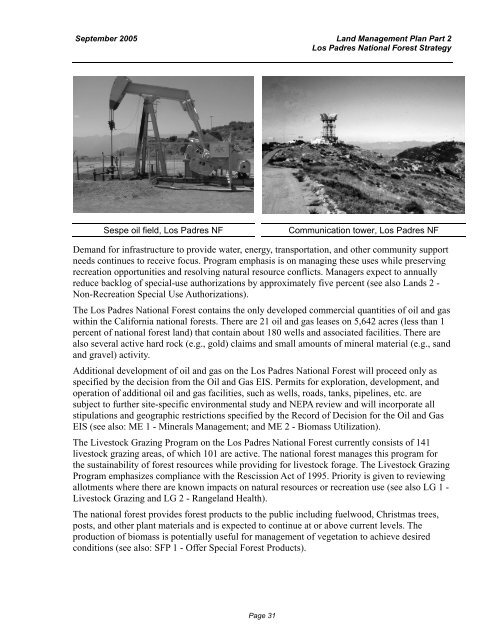Land Management Plan - Part 2 Los Padres National Forest Strategy
Land Management Plan - Part 2 Los Padres National Forest Strategy
Land Management Plan - Part 2 Los Padres National Forest Strategy
Create successful ePaper yourself
Turn your PDF publications into a flip-book with our unique Google optimized e-Paper software.
September 2005 <strong>Land</strong> <strong>Management</strong> <strong>Plan</strong> <strong>Part</strong> 2<br />
<strong>Los</strong> <strong>Padres</strong> <strong>National</strong> <strong>Forest</strong> <strong>Strategy</strong><br />
Sespe oil field, <strong>Los</strong> <strong>Padres</strong> NF Communication tower, <strong>Los</strong> <strong>Padres</strong> NF<br />
Demand for infrastructure to provide water, energy, transportation, and other community support<br />
needs continues to receive focus. Program emphasis is on managing these uses while preserving<br />
recreation opportunities and resolving natural resource conflicts. Managers expect to annually<br />
reduce backlog of special-use authorizations by approximately five percent (see also <strong>Land</strong>s 2 -<br />
Non-Recreation Special Use Authorizations).<br />
The <strong>Los</strong> <strong>Padres</strong> <strong>National</strong> <strong>Forest</strong> contains the only developed commercial quantities of oil and gas<br />
within the California national forests. There are 21 oil and gas leases on 5,642 acres (less than 1<br />
percent of national forest land) that contain about 180 wells and associated facilities. There are<br />
also several active hard rock (e.g., gold) claims and small amounts of mineral material (e.g., sand<br />
and gravel) activity.<br />
Additional development of oil and gas on the <strong>Los</strong> <strong>Padres</strong> <strong>National</strong> <strong>Forest</strong> will proceed only as<br />
specified by the decision from the Oil and Gas EIS. Permits for exploration, development, and<br />
operation of additional oil and gas facilities, such as wells, roads, tanks, pipelines, etc. are<br />
subject to further site-specific environmental study and NEPA review and will incorporate all<br />
stipulations and geographic restrictions specified by the Record of Decision for the Oil and Gas<br />
EIS (see also: ME 1 - Minerals <strong>Management</strong>; and ME 2 - Biomass Utilization).<br />
The Livestock Grazing Program on the <strong>Los</strong> <strong>Padres</strong> <strong>National</strong> <strong>Forest</strong> currently consists of 141<br />
livestock grazing areas, of which 101 are active. The national forest manages this program for<br />
the sustainability of forest resources while providing for livestock forage. The Livestock Grazing<br />
Program emphasizes compliance with the Rescission Act of 1995. Priority is given to reviewing<br />
allotments where there are known impacts on natural resources or recreation use (see also LG 1 -<br />
Livestock Grazing and LG 2 - Rangeland Health).<br />
The national forest provides forest products to the public including fuelwood, Christmas trees,<br />
posts, and other plant materials and is expected to continue at or above current levels. The<br />
production of biomass is potentially useful for management of vegetation to achieve desired<br />
conditions (see also: SFP 1 - Offer Special <strong>Forest</strong> Products).<br />
Page 31
















